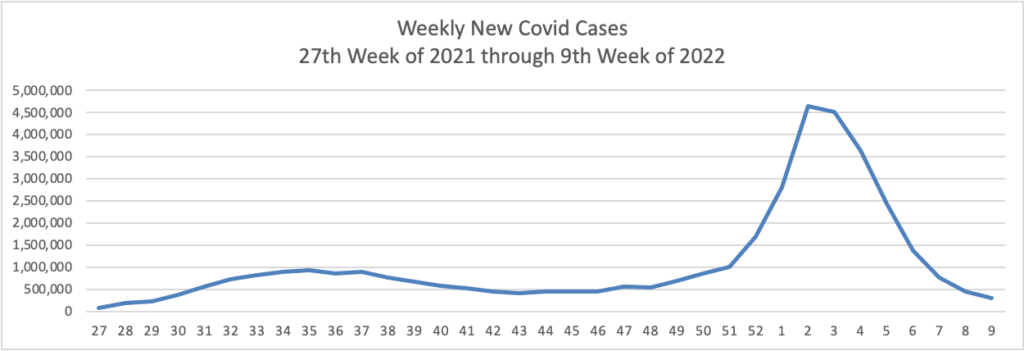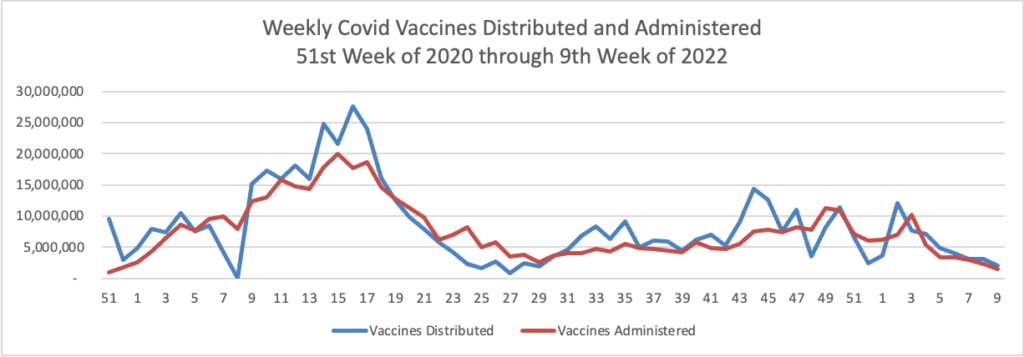Based on the Centers for Disease Control’s Covid Data Tracker and using Thursday as the first day of the week, here is the FEHBlog’s latest weekly chart of new Covid cases

The American Hospital Association informs us
The Centers for Disease Control and Prevention yesterday said more than 90% of the U.S. population now lives in a county with a low or medium COVID-19 Community Level, a new CDC measure for communities considering whether to require face coverings in public indoor settings. The agency plans to update the county data every Thursday going forward.
Becker’s Hospital Review adds
Cases of the highly transmissible omicron subvariant appear to be doubling every week in the U.S., but there isn’t clear evidence BA.2 will cause another major surge, epidemiologist Michael Osterholm, PhD, told Becker’s March 2. * * *
Cases will likely continue to drop over time, Dr. Osterholm said, adding he is hopeful cases will reach or fall below levels not seen since last June, when the nation’s new case average fell below 12,000.
It’s worth noting that the FEHBlog weekly chart of new cases found above begins with the low point Dr. Osterholm references, new cases under 12,000 and new deaths under 1,000.
Here’s the FEHBlog’s weekly chart of new COVID deaths

Here’s the FEHBlog’s weekly chart of Covid vaccinations distributed and administered from the 51st week of 2020 through the 9th week of 2022

From the Covid vaccine front, Bloomberg informs us
Parents still hesitating to get their kids vaccinated may be reassured by reporting that shows Covid inoculations protected children and teenagers from severe disease, even after the rise of the immune-evasive omicron variant.
Omicron came to the U.S. late last year armed with some 30 mutations in its spike protein that make it less recognizable to immune antibodies. Afterward, vaccine protection against infection and urgent care visits declined for 5- to 17-year-olds who’d received primary inoculations, according to U.S. Centers for Disease Control and Prevention data released Tuesday. However, vaccinated children and teens were still less likely to get infected than their unvaccinated peers, the agency said in its Morbidity and Mortality Weekly Report.
The CDC released recommendations last week saying that schools in areas of low and moderate risk can drop indoor mask mandates, the first update to its guidance on the topic since July — and the new findings may add confidence in moves to relax social measures as infections fall across the U.S. But many parents have been slow to get shots for their kids since the vaccine was recommended in November, and vaccinations among kids ages 5 to 11 have fallen to their lowest levels since the shots were first cleared.While kids generally don’t get as sick as adults from the coronavirus, clearing a vaccine for elementary school-age children marked a major milestone in the pandemic. It provided peace of mind for many concerned parents, allowing kids to resume activities that had been on hold since the virus first began spreading in the U.S.
Pfizer and BioNTech’s is the only shot that has been authorized for use in U.S. children and teens. The CDC looked at vaccine protection against infection, urgent care visits, hospitalization, and death among vaccinated children ages 5 through 11 and adolescents ages 12 through 17 before and during the omicron surge.
That’s solid information for health plans to share with their members.
Here’s a link to the CDC’s Weekly Review of its Covid statistics. Beckers Hospital Review saves you time by breaking down those stats at this link.
The CDC’s weekly FluView tells us “Sporadic influenza activity continues across the country. In some areas, influenza activity is increasing.”
From Capitol Hill, Roll Call informs us
Negotiations over an omnibus spending package remained far from complete Thursday as the late arrival of a White House supplemental funding request threw a wrench in the talks.
The White House on Thursday formally asked lawmakers to attach to the fiscal 2022 spending package $32.5 billion in emergency funds for government response efforts to the ongoing COVID-19 pandemic and Russian war with Ukraine.
The long-awaited details from the administration on its justification for the extra spending, on top of the roughly $1.5 trillion expected to be appropriated for the current fiscal year, come barely a week before stopgap funding expires March 11.
To pass the omnibus before that deadline, Senate Appropriations ranking member Richard C. Shelby, R-Ala., said lawmakers need to get a final deal by Tuesday — and even that may be too late to avoid the need for another short-term continuing resolution.
“We made good progress this week. But we make progress and we’re stalled,” he said. “And we can’t afford to stall this weekend. If we do, we’re headed for a CR.”
From the SOTU front, AHIP released AHIP President Matt Eyles’s comments on the President’s address.
From the health equity front, Mercer Consulting released a report finding a surprising gender gap in employer-sponsored health benefits continues to exist.
